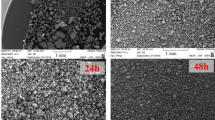The microindentation, macrohardness, and uniaxial compression methods are used to examine the effect of porosity (5–35%), content of the other phase (TiC or TiN, 5–70 vol.%), and loading temperature (20–1300°C) on the mechanical properties of Ti3SiC2/TiC, Ti3AlC2/TiC, and Ti4AlN3/TiN nanolaminate composites produced by reaction sintering of powder mixtures. A comparative analysis of the mechanical properties shows that the strength of the materials increases in the following sequence: Ti3AlC2/TiC, Ti4AlN3/TiN, and Ti3SiC2/TiC. Temperature–strain and force boundaries of their existence in the deformed state are established. Among all porous nanolaminate composites investigated, Ti3SiC2/TiC is the most optimal in respect to porosity, content of the other phase, and strength: 24% porosity and 30 vol.% titanium carbide.
Similar content being viewed by others
References
M. W. Barsoum, “The MN+1AXN phases: A new class of solids; thermodynamically stable nanolaminates,” Prog. Solid St. Chem., 28, 201–281 (2000).
M. W. Barsoum, T. El-Raghy, and M. Radovic, “Ti3SiC2: A layered machinable ductile carbide,” Interceram., 49, No. 4, 226–233 (2000).
N. P. Brodnikovksii, É. P. Pechkovskii, S. A. Firstov, et al., “Mechanical behavior of titanium–silicon carbide Ti3SiC2 depending on the structural state and deformation conditions,” Metallofiz. Noveish. Tekhnol., 25, No. 9, 1179–1200 (2003).
H. Zhang, Z. G. Wang, Q. S. Zang, et al., “Cyclic fatigue crack propagation behavior of Ti3SiC2 synthesized by pulse discharge sintering (PDS) technique,” Scr. Mat., 49, 87–92 (2003).
W. B. Zhou, B. C. Mei, and J. Q. Zhu, “Fabrication of high-purity ternary carbide Ti3SiC2 by spark plasma sintering technique,” Mat. Let., 59, 1547–1551 (2005).
S. A. Firstov and E. P. Pechkovsky, “Structure and mechanical properties of sintered compact and porous nanolaminates (Ti3SiC2) in the temperature range 20–1300°C,” in: 2004 Powder Metallurgy World Congress (October 17–21, 2004, Vienna, Austria), Vienna (2004), Vol. 4, pp. 725–730.
V. F. Gorban’, B. V. Vinokurov, O. N. Grigor’ev, et al., “Microindentation and macroindentation of titanium silicon carbide Ti3SiC2,” Powder Metall. Met. Ceram., 44, No. 3–4, 181–190 (2005).
S. A. Firstov, É. P. Pechkovskii, I. I. Ivanova, et al., “Effect of the composition and porosity of sintered titanium nanolaminates on the mechanical properties at high temperatures,” Probl. Prochn., No. 6, 79–94 (2006).
Yong Du, Julius C. Schuster, Hans J. Seifert, and Fritz Aldinger, “Experimental investigation and thermodynamic calculation of the titanium–silicon–carbon system,” J. Am. Ceram. Soc., 83, No. 1, 197–203 (2000).
F. H. Hayes, “Titanium–aluminum–carbon system,” in: G. Petzow and G. Effenberg (eds.), Ternary Alloys, Vol. 3, 557–566 (1990).
O. M. Barabash and Yu. N. Koval’, Structure and Properties of Metals and Alloys. Crystal Structure of Metals and Alloys [in Russian], Naukova Dumka, Kiev (1986), p. 598.
S. Konoplyuk, T. Abe, T. Uchimoto, and T. Takagi, “Synthesis of Ti3SiC2/TiC composites from TiH2/SiC/TiC powders,” Mat. Let., 59, 2342–2346 (2005).
E. Aznakayev, “Micron-gamma for estimation the physical-mechanical properties of micromaterials,” in: Proc. Int. Conf. ‘Small Talk–2003’, San Diego, California, USA (2003), TP.001, p. 8.
ISO 14577-1:2002(E), Instrumented Indentation Test for Hardness and Materials Parameters, Part 1: Test Method, September 22 (2002).
S. A. Firstov, V. F. Gorban’, É. P. Pechkovskii, and N. A. Mameka, “Indentation equation,” Dop. NAN Ukrainy, No. 12, 100–106 (2007).
S. A. Firstov, V. F. Gorban’, É. P. Pechkovskii, and N. A. Mameka, “Relation of strength characteristics of materials with instrumented indentation data,” Materialoved., No. 11, 26–31 (2007).
V. F. Gorban’, N. A. Mameka, É. P. Pechkovskii, and S. A. Firstov, “Identification of the structural state of materials by instrumented indentation,” in: Kharkov Nanotechnology Assembly-2007. Volume I. Nanostructured Materials [in Russian], Kharkov (2007), pp. 52–55.
S. A. Firstov, V. F. Gorban’, and É. P. Pechkovskii, “Ultimate strains and stresses in nanomaterials,” in: Kharkov Nanotechnology Assembly-2008. Volume II, Nanomaterials: New Favorites in Industry [in Russian], Kharkov (2008), pp. 145–153.
Author information
Authors and Affiliations
Corresponding author
Additional information
Translated from Poroshkovaya Metallurgiya, Vol. 49, No. 7–8 (474), pp. 56–68, 2010.
Rights and permissions
About this article
Cite this article
Firstov, S.A., Gorban’, V.F., Ivanova, I.I. et al. Mechanical properties of porous Ti3SiC2/TiC, Ti3AlC2/TiC, and Ti4AlN3/TiN nanolaminates at 20 to 1300°C. Powder Metall Met Ceram 49, 414–423 (2010). https://doi.org/10.1007/s11106-010-9252-2
Received:
Published:
Issue Date:
DOI: https://doi.org/10.1007/s11106-010-9252-2




